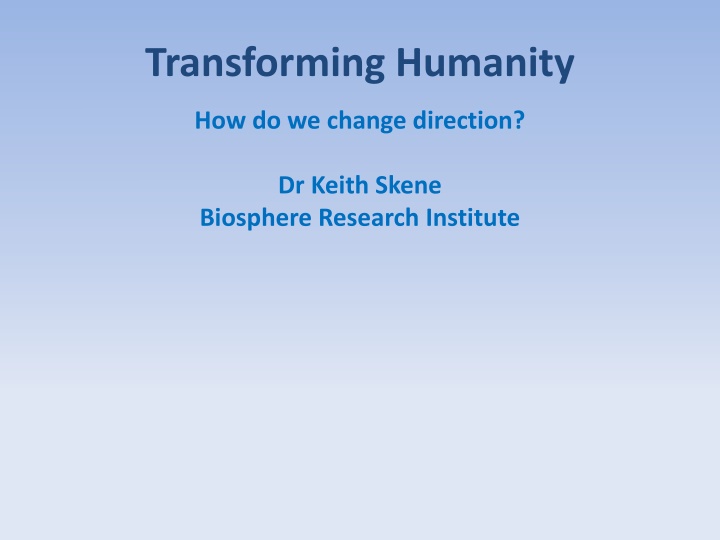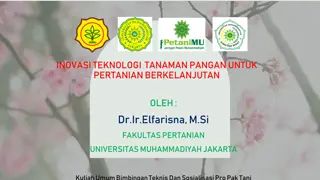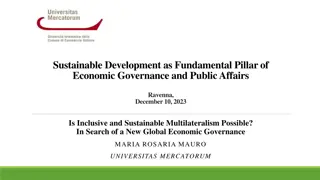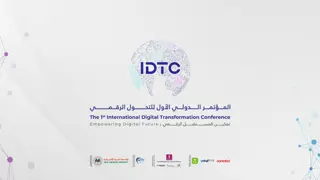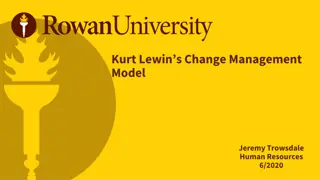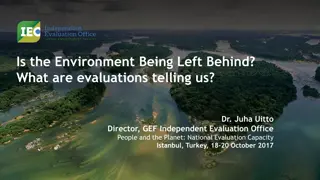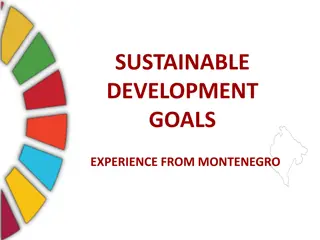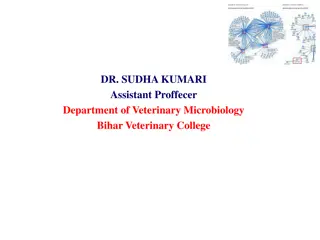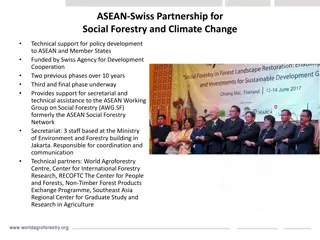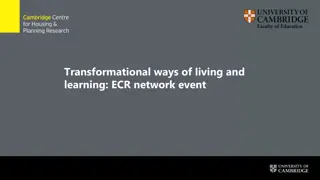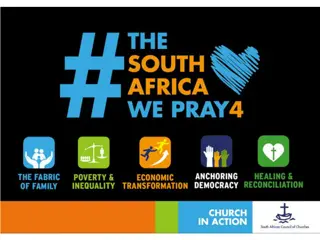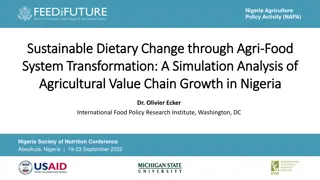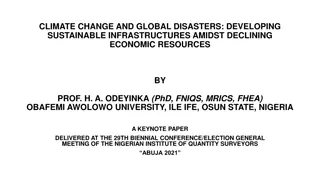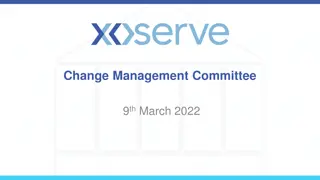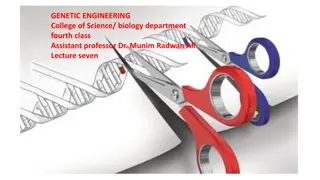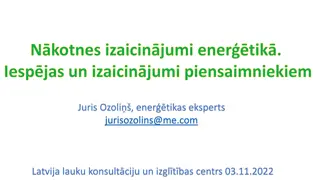Exploring Transformation and Change for a Sustainable Future
Delve into the discussions led by Dr. Keith Skene at the Biosphere Research Institute on transforming humanity and changing course towards a more sustainable direction. Engage in projects, delve into transition theory, measure change, and explore overcoming barriers to transition. Reflect on the necessity of altering mindsets and beliefs, as eloquently expressed in quotes by Daniel Quinn and Lucy H. Pearce, to pave the way for a new paradigm.
Download Presentation

Please find below an Image/Link to download the presentation.
The content on the website is provided AS IS for your information and personal use only. It may not be sold, licensed, or shared on other websites without obtaining consent from the author.If you encounter any issues during the download, it is possible that the publisher has removed the file from their server.
You are allowed to download the files provided on this website for personal or commercial use, subject to the condition that they are used lawfully. All files are the property of their respective owners.
The content on the website is provided AS IS for your information and personal use only. It may not be sold, licensed, or shared on other websites without obtaining consent from the author.
E N D
Presentation Transcript
Transforming Humanity How do we change direction? Dr Keith Skene Biosphere Research Institute
The plan Study transition theory Apply theory to practice in a group project Explore a new package of transition.
The Project You will be divided into small groups You will be given a brief Each week you will work on the brief while continuing to assimilate knowledge You will be provided access to a website with additional resources In week 4 you will present your solutions and face an inquisition (which, obviously, no-one expects )
Questions and observations Stop me at any time Email me (www.biosri.org) Access the web site for more reading.
Week One. Transition: from where and to what? A brief history of change. Project for Change I Week Two. Measuring transition. Project for Change II Week Three. Systems, society and me: the three levels of change. Project for Change III Week Four. Overcoming the barriers to transition. Project for Change IV. Presentations.
As long as the people of your culture are convinced that the world belongs to them and that their divinely-appointed destiny is to conquer and rule it, then they are of course going to go on acting the way they ve been acting for the past ten thousand years You can t change these things with laws. You must change people s minds. And you can t just root out a harmful complex of ideas and leave a void behind; you have to give people something that is as meaningful as what they ve lost something that makes better sense than the old horror of Man Supreme, wiping out everything on the planet that doesn t serve his needs directly or indirectly. - Daniel Quinn (1992). Ismael: An Adventure of Mind and Spirit
Those in the System, would like us to share their belief that all the changes are not connected: they are simply anomalies, isolated symptoms to be treated or preferably ignored, before the all-powerful Western capitalist patriarchal model goes on to ever greater heights and grander ejaculations. Most are numb to it, caught in fear, denial or resistance. But we, Burning Woman, know this process intimately. Amongst Burning Women and Men, there is a fierce, quiet knowing that these are both the death pangs of the old, and the birthing pangs of the new. Lucy H. Pearce (2016). Burning Woman
Transitions INDIVIDUAL TRANSITION
Transitions TRANSITION Adolescence Childbirth Moving house/school/job Demotion Promotion Unemployment Retirement Beginning of a close relationship End of a close relationship.
What is a social transition? A transition is defined as a long term process it may take one or more generations of non-linear social change leading to new constellations of actors, structures and practices, which determine the functioning of the system De Haan, 2007.
Sustainable transition A radical transformation towards a sustainable society as a response to a number of persistent problems confronting contemporary modern societies (Grin et al., 2010; p.1).
Thomas Berry Thomas Berry s notion of The Great Work, a transition which he called the Ecozoic, from the period when humans were a disruptive force on the planet Earth to the period when humans become present to the planet in a manner that is mutually enhancing (Berry, 1999).
COMMUNITY NATURE INDIVIDUAL
Sustainable transitions differ from previous transitions Sustainability transitions are goal-oriented or purposive The major areas where change is needed such as energy, food and car manufacturing are occupied by large incumbent firms with strong positions.
The mechanics of transition transitional models
What are the mechanics of transition, and how can we plan the process? It really depends on two things. Is it a random, ahistorical event Or is there a predictable, determinate and applicable formula that can be seen through history? Two major schools of thought exist.
Two approaches: build or emerge Builders believe in reductionism, selection, technology and the Enlightenment Weak sustainability model Emergent transition is not predictable and cannot be built, merely facilitated diffusional model Strong sustainability model.
The Viennese and Dutch schools of transition
The Viennese School of sustainable transition Analyses contemporary and historical phenomena of radical change in societies linked to change in their relations to the environment Sociology and history are core tools of this approach, and are used to calculate socio- metabolic profiles
According to the Viennese approach, the key to a transition is a society s energy system, and the impact of changes in this energy system is different across scale levels Socio-metabolic regimes represent dynamic equilibria of society nature interactions and are characterized by typical patterns of material and energy flows. Marina Fischer-Kowalski
Problems with using previous transitions to inform us 1. The narrative flowing through the first three ages is merely an account of gradual development Only the hunter-gatherer to agrarian transition is noteworthy, where a complete change in system occurred.
The foundations laid Settle Farm Congregate Division of labour Create surplus Trade Exercise control through strength.
Other problems with the SM approach 2. None of the transitions were planned; 3. None of them were universally transformative we have all four ages here today; 4. None of them form a model for salvation; 5. There were three very different challenges (famine, war and disease) compared to today (pollution, soil and ecosystem collapse).
Dutch Knowledge Network on System Innovation and Transitions (KSI) focuses upon driving system innovation forward by achieving socio-cultural, institutional, economic, and technological changes The status quo is visualized as a dynamic rather than a static equilibrium, which is then disturbed. Johan Schott
Four stages of KSI 1. The pre-development phase arises from a dynamic state of equilibrium 2. The take-off phase represents the actual point of ignition after which the process of structural change gathers pace; 3. The acceleration phase in which structural changes become obvious; 4. The stabilization phase where a new dynamic state of equilibrium is achieved (Rotmans et al. 2001).
Catalyst not construct: an emergent model The Dutch approach holds that transitions cannot be steered or controlled due to their complexity However, there is a belief that the speed and direction of change can be guided.
Types of transition Transitions can be classified into eight types based on three axes: 1. teleological vs. emergent; 2. degree of coordination (from high to low); 3. level of aggregation (high vs. low).
For example, the internet is viewed as an emergent, hardly coordinated, and highly aggregated transition while the transition from coal to gas is classed as a teleological, highly coordinated, and slightly aggregated transition.
Problems with KSI If we consider the present era, we would identify it as nearing the end of the acceleration phase, with technology, production and population all expanding rapidly And so we are yet to emerge into a new equilibrium.
However the industrial and technological advances are coming into collision with ever increasing natural threats (ecosystem function collapse and resource exhaustion) Thus the Dutch model may not be relevant as there has never been such unprecedented consequences of human behaviour in the past, placing us in a new situation.
Fischer-Kowalski, M., and J. Rotmans. 2009. Conceptualizing, observing, and influencing social ecological transitions. Ecology and Society 14(2): 3. https://www.ecologyandsociety.org/vol14/iss 2/art3/ A nice paper by two of the main protagonists of these two schools, comparing their work.
Transition culture The movement works towards developing communities that are more locally resilient by reducing the reliance on global oil production, while locally responding to environmental issues Transition culture is more focused on strong sustainability responses rather than centralized weak sustainability approaches.
The spread of transition Transitions are not thought of as emerging from a single point, and diffusing outwards, but rather they occur in different locations, and modulate into a significant change These ideas are difficult in terms of differences in starting points, cultures and geo-political heterogeneity across the planet.
What kind of a transition - a sustainable future? In attempting to envisage what kind of a transition is needed, we must first identify what the goals of such a transition are What are we transitioning towards and from? ? ? What does this destination actually look like? Economic, social and environmental? How do we get there? Do we have to leave from the same station?
Starting points differ !Kung hunter gatherers Kenyan shamba agrarian Indian nail factory industrial American agriculture - technological
Different departure stations HUNTER GATHERER AGRARIAN INDUSTRIAL TECHNOLOGICAL
The One Path Approach HUNTER GATHERER TECHNOLOGICAL AGRARIAN INDUSTRIAL A SUSTAINABLE FUTURE
Issues with development Arturo Escobar: Development can be described as an apparatus that links forms of knowledge about the Third World with the deployment of forms of power and intervention resulting in the mapping and production of Third World societies https://www.theguardian.com/global- development/2012/nov/05/arturo-escobar-post-development- thinker
Jean Marc Ela, Cameroonian sociologist Africa is not against development. It dreams of other things than the expansion of a culture of death or an alienating modernity that destroys the fundamental values so dear to Africa Africa sees further than an all- embracing world of material things and the dictatorship of the here and now, that insists in trying to persuade us that the only valid motto is I sell, therefore I am . In a world often devoid of meaning, Africa is a reminder that there are other ways of being From: Ela, J. (1998) Western development has failed: looking to a new Africa. Le Monde Diplomatique, October 1998. https://mondediplo.com/1998/10/06africa
Maldevelopemnt What is referred to today as development is actually maldevelopment . It is designed and driven by external forces for the profits and control of external agents and actors. The World Bank generates $3 of business for western companies for every dollar it lends to the Third World for development . Development allows $500billion to flow out from the Third World to the rich West in interest and debt payments and low prices for Third World products, while $50billion goes in the opposite direction as development aid.
It is time to move beyond the fictions and illusions of economic growth which siphons wealth from the poor to the rich, and take into account the reality of ecological catastrophes and social disintegration that have been unleashed by development processes and which leave the poor poorer.
A Different Perspective HUNTER GATHERER AGRARIAN INDUSTRIAL TECHNOLOGICAL
Different Destinations (Pluriverse) HUNTER GATHERER AGRARIAN INDUSTRIAL TECHNOLOGICAL A A SUSTAINABLE FUTURE SUSTAINABL E FUTURE A SUSTAINABLE FUTURE
THE RIVER OF PROJECT PROGRESS Arno NILE Euphrates
